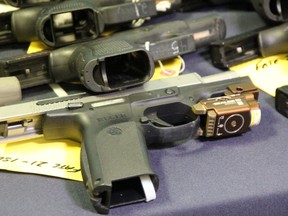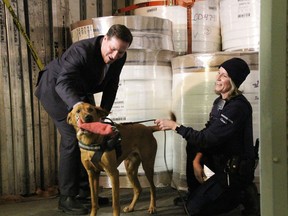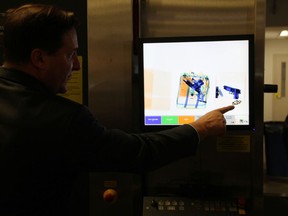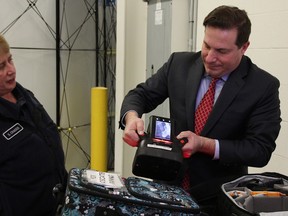Drug and weapon seizures at the Blue Water Bridge have been on the rise, Canada Border Services Agency officials and Canada’s public safety minister say.

Drug and weapon seizures at the Blue Water Bridge have been on the rise, Canada Border Services Agency officials and the federal public safety minister say.
Border services officers seized about 870 kilograms of cocaine, methamphetamine and heroin in 2022, officials said during a Tuesday visit to the crossing between Point Edward and Port Huron, Mich., by Public Safety Minister Marco Mendicino.
The total amount of illegal drugs pulled from commercial trucks crossing the border is roughly four times as much as what was seized in each of the previous three years, said Rob Wilson, the acting Canada Border Services Agency (CBSA) director for the bridge crossing. About three-quarters of drugs seized during the past year has been cocaine, the director noted.
“Ninety-nine per cent of heroin, pink cocaine and methamphetamine in the southern Ontario region come through this border crossing alone,” Wilson said.
Yet, the crossing doesn’t have 24-7 canine unit coverage or other specialized teams that some other border crossings boast, canine unit officer Vince Sutton said.
“That’s a testament to how much is coming across every single day,” he said, “so we can get more. The sky is the limit for how much we can actually intercept.”

About 160 border service officers work at the crossing, a roughly 10 per cent increase during the last three years, thanks to federal funding, Wilson said Tuesday while standing in front of a table of about 60 guns seized from would-be smugglers crossing the bridge
There were 69 handguns, rifles, shotguns and semi-automatic rifles seized at the border crossing in 2022, not including replicas and prohibited antiques, numbers provided by Wilson showed.
More than 4,200 “other weapons” were also seized by border officers.
“The major investments the Canadian government has made in our technology – our X-ray technology, our large-scale imaging technology and our canine units – has made it possible for us to take all of this off the streets of Canada,” Wilson said .
Mendicino spent about an hour in the Point Edward dock where commercial vehicles are parked for secondary inspection. The minister heard about the seizures and new technology that federal funding has helped purchase, like a portable X-ray scanner that can be used to help find concealed weapons and drugs.

“We’re going to continue to invest in the CBSA,” said Mendicino, noting Tuesday’s stop was one of several on a tour of border crossings across the country.
The federal government has invested $450 million in the past two years to hire more officers and to equip them with more advanced technology, he said.
The progress made at border crossings like the Blue Water Bridge in seizing more and more contraband is also due to the professionalism and hard work of front-line officers, he noted.
“Smart gun control policies like Bill C-21,” said $250 million Building Safer Communities Fund to help deter at-risk youth from “going down a path of crime” and co-operation between different levels of governments are all part of a federal strategy to reduce gun violence and attack organized crime, Mendicino said.

There were also 370 narcotic seizures from vehicles besides commercial trucks crossing the border in 2022, numbers provided by Wilson showed. The weight wasn’t specified.
The number of drug seizures from bridge traffic, excluding commercial trucks, has remained flat for the past four years, the numbers showed.
Mendicino was also asked about possible approaches to thwart technology, such as drones, being used to move contraband across borders while circumventing officials crossings.
A drone carrying a bag containing 11 handguns was found in a tree near Port Lambton last spring was believed, police said at the time, to have crossed from the United States.

Investing in the CBSA, including “additional capacity,” is part of that solution, Mendicino said.
“So they have the state-of-the art technology that they need to stop drones, to stop organized crime from getting illegal guns and drugs across the border,” he said.
“And again, what we saw here today on display was the product of work that is, quite bluntly, exceptional. Sarnia is ranking first when it comes to (seizures of) a lot of the illegal drugs.”
